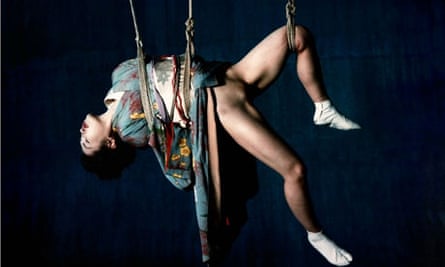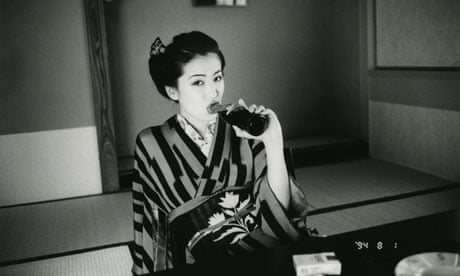In 1992, when the Japanese photographer Nobuyoshi Araki presented a series of loud, intermittently shocking images at a gallery in Austria, the institution's female guards walked out. Araki's photographs were sexist, degrading, oppressively fetishistic, they argued; if the work was installed, they wouldn't be coming back.
The photographer has now spent 40 years capturing women in various states of undress. Sometimes they are doused in paint. Sometimes they are laid bare on household furniture. Sometimes they're trussed in rope, partly covered by traditional robes, hung disconcertingly from the ceiling or positioned kneeling on the floor. The models are consenting, and Araki's intentions mostly playful. Still, it's hardly everyone's cup of tea.
Only a portion of Araki's images are sexually explicit. A diarist, the 72-year-old photographer lives through his art, capturing – quickly, messily, honestly – the mundanities of everyday life. He has shot complex cityscapes and high-energy karaoke bars, blooming flowers and colourful children's toys, normal Japanese folk and international megastars. (Bjork, whom he photographed for the cover of her 1997 remixes album Telegram, has called him "the most energetic man I know".) He documents meals, walks, every sky he wakes up to. When he says "life is itself photography", you get the impression he really means it.
An exhibition of Araki's work has opened in London this week, coinciding with the publication of a pricey Taschen tome, Bondage – three volumes of the photographer's Kinbaku (or "tight binding") imagery. The show features a kimono-clad woman sipping Coke, a snapshot of a Japanese singer on TV, a couple of exotic flowers. But it will feature bondage imagery, too, which gallery director Michael Hoppen acknowledges is risky. "I know we'll be vilified by some areas of the press," he says, "but I believe it poses some interesting questions."
Those questions are twofold. First, where does the line between art and pornography fall? And second, how much of Araki's work is part of a bigger Japanese tradition? In an attempt to answer both, Hoppen has offset the photographer's work with a small selection of original shunga, Japanese woodblock prints widely distributed between the 17th and 20th centuries. Exquisitely crafted and often brightly coloured, these feature kimono-wearing couples performing physically improbable sexual acts: half-dressed on the living-room floor, masturbating concurrently in lavish bedrooms, carrying on beneath a mess of robes, all with their genitals enlarged. "They're highly explicit," Hoppen says. "Much more explicit than Araki's work, but because hundreds of years have passed since they were made, they've become artefacts rather than simply pornographic drawings."

Shunga became popular in the 1600s, a sexually charged extension of ukiyo-e, a genre of woodblock art that depicted a utopian Japanese lifestyle. First distributed in the country's major cities to a wealthy elite, rapid developments in printing technology brought shunga to a burgeoning middle class, who enjoyed both the fantastical sexual imagery and the typically humorous conversations printed alongside. As demand grew, so did production. "Each book would typically include two or three volumes," says Tim Clark, head of the Japanese section at the British Museum, which will hold an extensive exhibition of shunga in October. "Each volume would contain a set of dozens of images. We're talking about thousands and thousands of printed images."
Books were produced by some of the best-known ukiyo-e artists of the day (Hokusai and Utamaro, among others), who created sexual adventure for a mainstream audience neither afraid nor embarrassed to embrace erotic imagery. But was it art? "Absolutely so," says Clark. "But you've got to bear in mind that in the west we've come up with this notion that art and pornography are separate, that there's an absolute firewall between the two. Shunga is a profoundly different equation – it's both explicit sexually and very sophisticated artistically. That's an equation in pre-modern times we weren't really used to."
Shunga was banned in 1722, then again some 70 years later and once more in the 1840s – but government enforcement was lax, and book production continued until the early 20th century. By that point, Japan, previously isolated from the rest of the world, had opened its borders to foreign travellers, most of whom were surprised by the public prevalence of such explicit imagery. Perhaps embarrassed, authorities made moves to suppress any manifestation of Japanese culture that failed to tally with late 19th-century western notions of propriety, prompting shunga's sudden decline. It remained taboo in public and in academia until 1990 – only a couple of years before Araki offended those Austrian guards.
Araki has long been a fan of the art form. "I'd like to take photos similar to shunga," he once said, "but I haven't reached that level yet. There is bashfulness in shunga. The genitals are visible, but the rest is hidden by the kimono. In other words, they don't show everything. They are hiding a secret." Araki works along the fault lines of Japanese culture – between the public and the private, the civilised and the seedy. His work is popular (or offensive, depending on how you see it) in the west for the frisson of excitement it draws from those unfamiliar with Japanese cultural practice. But in Japan it chimes for its honesty. "It's about the double standard associated with Japanese culture," says Simon Baker, curator of photography at the Tate. "It's an incredibly polite, formal society on the surface, [but it] has this hidden underside of sexuality. Araki very effectively works on this relationship."
Is it art or is it porn? To Araki it makes little difference. In the end, his subject is the everyday – or his everyday – the poignant and the touching, the messy and the disturbing.

Comments (…)
Sign in or create your Guardian account to join the discussion